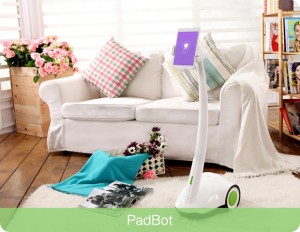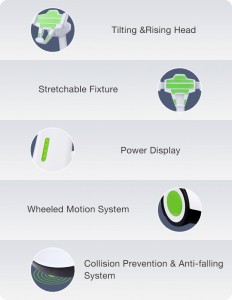Recently, another player popped up in the telepresence robotics world. And that offering is the PadBot.
 Now, in looking at the product, it has incredible similarities to various other players like vGo and double – a low-cost base and tablet headpiece.
Now, in looking at the product, it has incredible similarities to various other players like vGo and double – a low-cost base and tablet headpiece.
But to create differentiation, PadBot is offering a couple of features that have been seen in other devices:
- Tilting Head – similar to the vGo’s camera control, the head allows for the tablet to move up and down
 Expandable Mount – to allow for various devices with size and OS flexibility
Expandable Mount – to allow for various devices with size and OS flexibility- Collision and Cliff Detection – addressing pilot mishaps, the device is to have some form of sensors to detect edges and potential collision with objects
- Light-weight – along the lines of the double, the PadBot is estimated to weigh 5 kgs (without tablet)
- Fifteen hours running time – according to their estimates, a 15 hour continuous on their light-weight battery
- Supports Android and iOS – their communication app reminds us more of Skype than anything, which leads us to wonder how they will grow the userbase
Now, while these features are small, they do show that there will become alternatives to the vGo/double/Beam offerings, especially at a $399 estimated retail price.
Yes, that is the estimated price from their Indiegogo page. And, estimated mass delivery is is expected December 2014, but based on other crowdsourced projects, we give it a 30% probability of hitting their due date.
Additionally, what seems to be elegant in operation will soon become problematic in real-life. Like the double, it relies on the audio pickup and reproduction of whatever tablet being used. Additionally, it is dependent upon the front-facing camera and, since it is not mounted in a housing (like the double), augmenting the video performance with something like a fish-eye lens is not going to happen.
We also do not know what video protocol the PadBot support and whether or not it supports a downward facing camera (since the vGo suffered the same issue of only having a single camera to perform both functions). From the video below, it seems as though the video is added post-production to the solution (see how the pilots have the camera in their shot, and then look at the position of the camera on the PadBot’s screen – 90 degrees off). And, since they do not show any charging station, we have no idea where or how one will ensure charging and whether or not one will need the assistance of human operators to untether them.
We applaud InRobot for developing the PadBot, but we hope they learn from the other players on how to develop an even better model.





